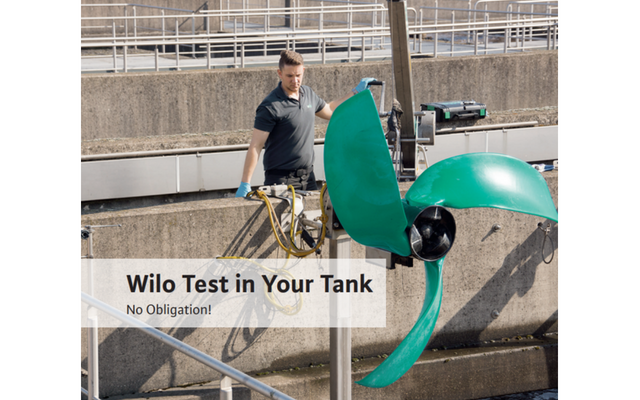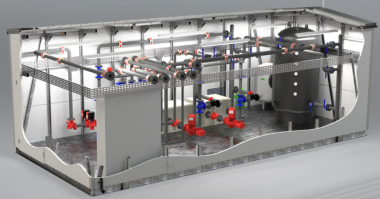Author: Harold Adams, National Sales Manager, Water Management, Wilo
Energy consumption is estimated to be roughly 20% of the operating costs of a wastewater plant. As more municipalities explore methods of reducing expenditure through both energy consumption and operational costs, submersible mixers are playing a larger role in the total energy and cost efficiency of wastewater treatment facilities, or plants. While blowers account for the largest percentage of a plant’s energy consumption at approximately 60%, the percentage attributed to mixers is estimated to be approximately 20%. However, a number of factors can increase or decrease this percentage by up to 5%, including the biological treatment process and the number of submersible mixers on site.
Mixers work to impart a certain amount of thrust into wastewater, or media, to keep solids suspended in a tank. A driver, or motor, is needed to create that thrust in conjunction with a propeller. With a direct-drive mixer, the motor’s revolutions per minute (RPM) determines how fast the mixer’s propeller rotates. Therefore, the speed of the propeller is fixed unless a secondary device, such as a variable frequency drive (VFD), is used. However, many municipalities opt not to use a VFD due to added capital costs and required maintenance post-installation. The challenge for most plant operation groups then becomes providing the required amount of thrust to achieve proper mixing while consuming the least possible amount of energy.
For decades, Wilo has been innovating mixing equipment by taking two additional factors unique to our design into consideration; the propeller and the single or multistage gearing system. Rather than simply focusing on horsepower to achieve thrust, we focus on the propeller diameter, materials and design, coupled with the proprietary gearing system, to offer something truly unique to the mixer market.
Wilo’s mixer propellers are made from a molded polyurethane material that requires much less energy, or output, from a motor to rotate compared to a stainless steel propeller of the same size. Additionally, utilizing polyurethane allowed Wilo to significantly increase the diameter, thus amplifying the hydrodynamic properties of the propeller with a sweptback design similar to that of an airplane wing. For example, an airplane wing has a smooth, concave surface that has a larger surface area towards the front and tapers off towards the back. This creates a variance of pressure which encompasses the entire wing so that the higher pressure builds underneath as the air pressure above decreases, thereby creating a lifting effect. Wilo has taken this concept and applied it to our mixer propellers to create a larger, dynamic and uninterrupted blade design.
The material of construction in conjunction with the innovative propeller design allows Wilo mixers to impart the identical amount of thrust into the mixed media with a lower horsepower motor than a direct-drive mixer, thereby conserving energy during operation.
In addition to modifying the propellers, Wilo offers a unique one or two stage planetary gearing system for speed reduction in conjunction with a 4-, 6- or 8-pole motor. This motor, along with our proprietary gearing system, allows us to ‘dial in’ the thrust demand to meet a customer’s specific system and mixing requirements.
The standard method used to determine the speed of a direct-drive mixer (excluding a VFD, in this case), is to add poles to the motor. Consequently, the more poles added to a motor, the more expensive the mixer is to repair, rewind or maintain. In some cases, a motor can have anywhere between 14 to 16 poles (514 RPM and 450 RPM, respectively), however the maximum motor speed for Wilo gear-driven mixer motors is currently 840 RPM, thereby saving both capital costs for the initial point of sale and operational cost associated with repairs after the warranty period.
The potential energy savings combined with a four-year, 100% parts and labor warranty for all gear-driven mixers means that Wilo offers a premium product for one of the best values on the market.
Spending too much on power? Dealing with dead zones and sedimentation in your tank or basins? Let Wilo assist you in estimating your energy and maintenance savings with a Wilo gear-driven mixer.

Try Before You Buy – No Cost to You!
With Wilo’s exclusive, no-cost try-before-you-buy program, you can test a Wilo mixer in your own tank to see the benefits with no obligation to buy! Contact Wilo USA for your no-cost life cycle cost analysis or for more information on our Test in Your Tank program.





Comments